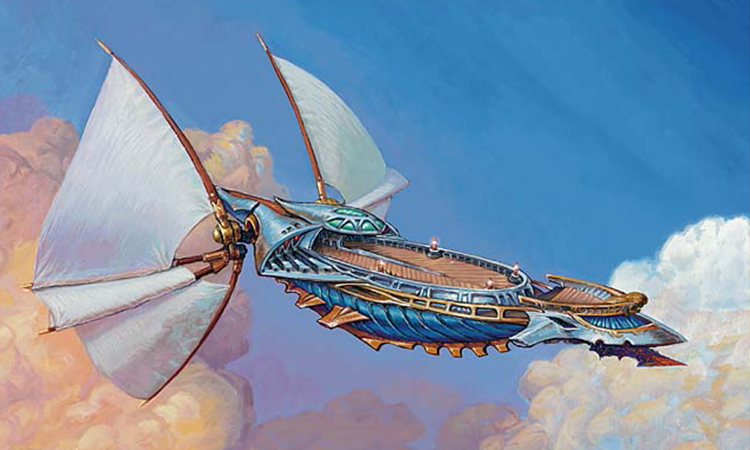Weatherlight came out in 1997 and kicked off the famous Weatherlight Saga—which has been compared to the more recent, more infamous Gatewatch, um...not-Saga? The set had three mechanics—flanking, phasing, and cumulative upkeep; while the Saga featured such famous characters as Squee, Gerrard, Captain Sisay, Hana, Mirri, and others. Flanking saw print again with last year's Sidar Kondo of JamuraaSidar Kondo of Jamuraa. Phasing got a recent update with the release of Commander 2017's Teferi's ProtectionTeferi's Protection (and we'll get to that when we talk about Teferi's VeilTeferi's Veil.) Perhaps next year's Commander product will feature new cards with cumulative upkeep??!? Wild speculation! All chips on cumulative upkeep! You heard it here first! Pick up your copies of SolemnitySolemnity now, folks! Ahem. Now, without further ado let's take a look at the underplayed gems buried deep in Weatherlight's past. 
The Cargo

Inner SanctumInner Sanctum sees play in 32 decks and does a decent impression of Rune-Tail's Essence (the flipped version of Rune-Tail, Kitsune AscendantRune-Tail, Kitsune Ascendant).

If you have SolemnitySolemnity in play, it's basically indistinguishable. If you run Soul's AttendantSoul's Attendant and Soul WardenSoul Warden as part of a Soul Sisters package in your white weenie token aggro deck, why wouldn't you play this card? You'll have plenty of life to pay off the cumulative upkeep. It saves your creatures from bad blocks, as well as red damage-based board wipes like Blasphemous ActBlasphemous Act. Or maybe you're running that Soul Sisters package in your Boros weenie token aggro deck, and you're the one slinging Blasphemous ActBlasphemous Act as a one-sided board wipe? Orzhov decks playing a death and taxes, lifelink, and/or life drain strategy also will have no problem paying the upkeep cost on this card. Typically, Orzhov decks want to be in control of when and how their creatures die, and this card lets them control that a little more precisely without having to worry so much about combat.
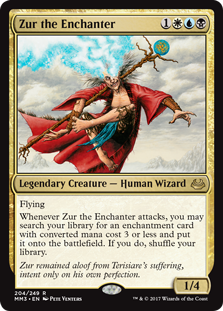
Playing this card the most at five decks, Zur the EnchanterZur the Enchanter can tutor this up to protect himself. Daxos the ReturnedDaxos the Returned likes enchantments and is in good colors to recoup the cost in life. Bruse Tarl, Boorish HerderBruse Tarl, Boorish Herder attacks a lot with lifelink and double strike, and doesn't really want to have to worry about dying to combat damage. The newly printed Licia, Sanguine TribuneLicia, Sanguine Tribune attacks, has lifelink, and gets progressively bigger. Seems like good synergy with Inner Sanctum to me. There are tons of life-oriented commanders; try this with any of them.

Debt of LoyaltyDebt of Loyalty is a permanent Mind ControlMind Control effect that sees play in 303 decks. This card doesn't quite work as worded. The Oracle text specifies that you only gain control of the creature if it regenerates this way, so it has to be on its way to the graveyard. But, hey, you're in white. Run all kinds of board wipes. Or let your opponents wipe the board, and steal the best creature out there. Or save your own best creature if they have nothing good. This card is a little bit like False DemiseFalse Demise in that regard, but since it's instant-speed your opponents can't see it coming. The regeneration mode gives it a bit of flexibility as well since you can effectively give your own creature indestructible if push comes to shove.

Brion StoutarmBrion Stoutarm runs this card the most at 29 decks. ThreatenThreatening a creature, flingflinging it at another creature, and then using Debt to steal the second creature seems like a lot of work for one dude. I suspect it's just there as a goodstuff, flexible card. This card has some good synergy in a Child of AlaraChild of Alara or Myojin of Cleansing FireMyojin of Cleansing Fire deck, or, if you're in a wrath-heavy meta, just throw this in your next white brew and see what happens.

AbjureAbjure is a one-mana CounterspellCounterspell that sees play in 443 decks. It has the additional low-low cost of sacrificing a blue permanent, but that's a minor hindrance at worst, and sometimes it's an upside. Blue/black decks get to use this as a reactive sacrifice effect, tucking a creature away in the graveyard for later use. Playing something like Chasm SkulkerChasm Skulker lets you blow it up and cash in on all of those sweet squid tokens. There are plenty of blue creatures like Champion of WitsChampion of Wits and Vizier of Many FacesVizier of Many Faces from Amonkhet and Hour of Devastation with the embalm and eternalize keywords, allowing you to bring your blue creatures back, and sometimes bring them back better.
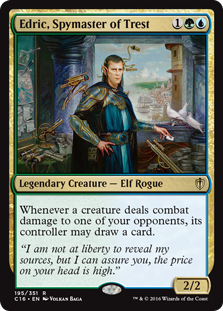
Edric, Spymaster of TrestEdric, Spymaster of Trest, who likes to keep a really tight mana curve, plays this card the most at 190 decks. Abjure is great for Talrand, Sky SummonerTalrand, Sky Summoner since you can just sacrifice an extraneous token. In Dimir, The Scarab GodThe Scarab God from Hour of Devastation has no problem losing a creature in the short-term to counter a nasty spell; while Gisa and GeralfGisa and Geralf recast a blue zombie from their graveyard each turn. Ravos, SoultenderRavos, Soultender, coupled with the blue partner of your choice, can bring that creature back to your hand during your next upkeep.

Teferi's VeilTeferi's Veil is a neat repeatable combat trick that sees play in 258 decks. It's funny, last time I talked about phasing it was to say how good it is at removing tokens, but now it's to talk about how it works well WITH your tokens. When Teferi's ProtectionTeferi's Protection came out in Commander 2017 they changed the rules on phasing tokens. Tokens now work just like anything else, phasing in just before your untap step. Teferi's Veil lets you attack with all your dudes, and then they cease to exist until your next turn allowing you to wipe the board with impunity!
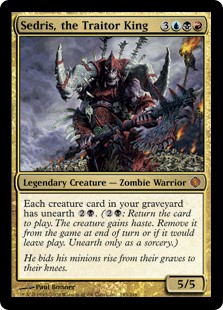
Sedris, the Traitor KingSedris, the Traitor King plays this card the most at 133 decks. He usually only gets one extra turn out of his reanimated minions, but Teferi's Veil lets him cheat. You can't exile something that isn't there! Now that the phasing rule has changed for tokens, running this card in Talrand, Sky SummonerTalrand, Sky Summoner lets you slowly accrue tokens that are resilient against board wipes and removal, while still being able to make blockers whenever you cast an instant. Teferi's Veil could be viable in a voltron deck as a means of protecting not only your commander but also whatever auras and equipment you have attached to it since they all phase in and out with whatever they're attached to.
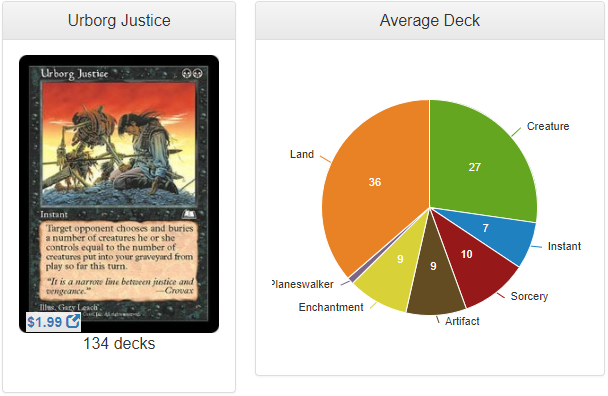
Urborg JusticeUrborg Justice is a great one-sided board wipe that sees play in 134 decks. If you're planning on swapping your creatures in and out of the graveyard with sacrifice effects then this card enables you to spring a surprise Grave PactGrave Pact effect against a single opponent. This is also great retaliation if people in your meta run lots of spot removal or board wipes that don't affect them like In Garruk's WakeIn Garruk's Wake and Plague WindPlague Wind.
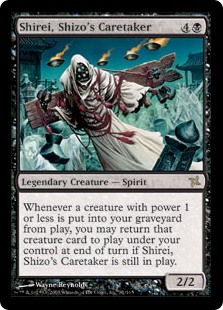
Recurring everything he sacrifices, Shirei, Shizo's CaretakerShirei, Shizo's Caretaker plays this card the most at 15 decks. Athreos, God of PassageAthreos, God of Passage, Ayli, Eternal PilgrimAyli, Eternal Pilgrim and Meren of Clan Nel TothMeren of Clan Nel Toth all run similar strategies to Shirei. Typically they're built with a large suite of low-cost, easily recurrable creatures like BloodghastBloodghast (well, maybe not Meren necessarily), or creatures that sacrifice themselves for value like Caustic CaterpilarCaustic Caterpilar and Sakura-tribe ElderSakura-tribe Elder. Commanders built to abuse Shadowborn ApostleShadowborn Apostle or Relentless RatsRelentless Rats should also be able to get tons of mileage out of Urborg Justice.
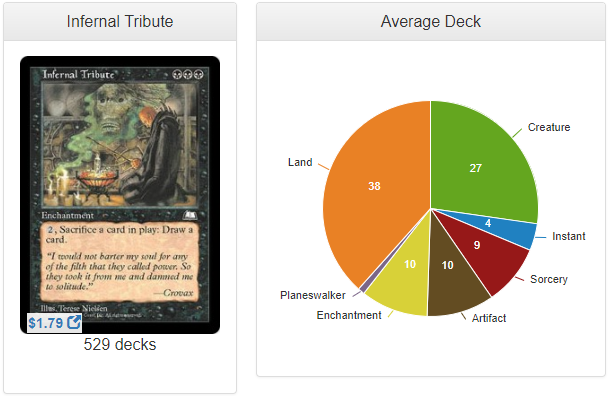
Among the most versatile sacrifice outlets in the game, Infernal TributeInfernal Tribute sees play in just 529 decks. Sacrifice anything! Artifacts, lands, enchantments, planeswalkers! Why would you want to sacrifice any of these things? To draw cards in response to an Anguished UnmakingAnguished Unmaking and Utter EndUtter End-type spot removal or Merciless EvictionMerciless Eviction-style wraths. Usually. Sometimes you're running Zealous ConscriptsZealous Conscripts effects and just want to deal with a very loyal planeswalker. Sometimes you have tokens. Sometimes you're just really desperate. Whatever your reasons, this card will take two mana, and anything on the board you have to offer, and let you draw a card off of it. And hey, you can always run it in conjunction with Urborg JusticeUrborg Justice to get just a little more bang for your buck.

Again, Shirei, Shizo's CaretakerShirei, Shizo's Caretaker plays this card the most at 92 decks. All the commanders that liked Urborg Justice are going to like this. Ayli, Athreos, Meren. Sedris, the Traitor KingSedris, the Traitor King could use this in case he can't get Teferi's VeilTeferi's Veil out and just wants to cash a body in for a quick card. Breya, Etherium ShaperBreya, Etherium Shaper loves to sacrifice artifacts, but there are only so many cards that let you do that. Infernal Tribute is one card on that very short list.

Seeing play in 76 decks, Hurloon ShamanHurloon Shaman is an Abyssal GatekeeperAbyssal Gatekeeper for lands. Oh, sure, it's just one land, and they get to choose it, but when you stack effects like this they can start to add up. Couple this with Price of GloryPrice of Glory, Stoneshaker ShamanStoneshaker Shaman, and Keldon FirebombersKeldon Firebombers and your opponents are going to start hurting. Just be sure to run a recursion and/or mana rock package or you'll start hurting, too.
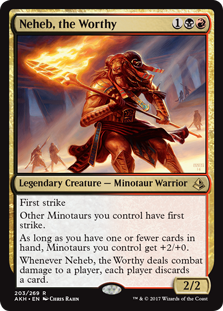
Neheb, the WorthyNeheb, the Worthy plays this card the most at 44 decks, probably for tribal synergies more than anything else. Recurring this with Feldon of the Third PathFeldon of the Third Path or Alesha, Who Smiles at DeathAlesha, Who Smiles at Death each turn can be devastating for your opponents' boards. I also like this card for a Shattergang BrothersShattergang Brothers deck that's fully prepared to play a long attrition game with a Crucible of WorldsCrucible of Worlds/Ramunap ExcavatorRamunap Excavator and WastelandWasteland/Strip MineStrip Mine package. Forcing the table to sacrifice a creature and a land, and then recurring it, is just so much value. When in doubt, Jund 'em out.
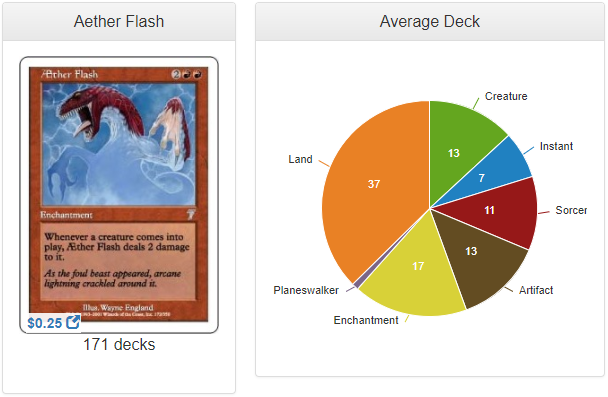
Aether FlashAether Flash is a soft creature lock that sees play in 171 decks. This card is so easy to build around I'm surprised it doesn't see more play. You just need to run creatures with toughness three or more, and you're good to go. I actually expect this card to see a sharp uptick in play after Ixalan comes out. The enrage mechanic that triggers whenever that creature is damaged is going to be really good with this card. Plus, the Seventh Edition art resembles a raptor, so it looks like it fits in art-wise.
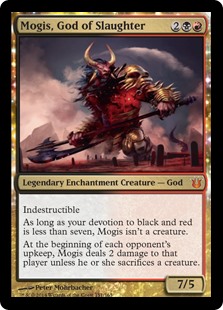
Mogis, God of SlaughterMogis, God of Slaughter, who tends to play lots of punisher cards, plays this card the most at 43 decks. Like I said, this card is going to be nuts in Gishath, Sun's AvatarGishath, Sun's Avatar with all those dinosaurs that like taking a little damage. This is good with some of the other red gods like Hazoret the FerventHazoret the Fervent and Iroas, God of VictoryIroas, God of Victory. Iroas is extra cool because he'll let your tokens that come into play attacking off of Hanweir GarrisonHanweir Garrison, Brimaz, King of OreskosBrimaz, King of Oreskos, and Hero of BladeholdHero of Bladehold survive Aether Flash.
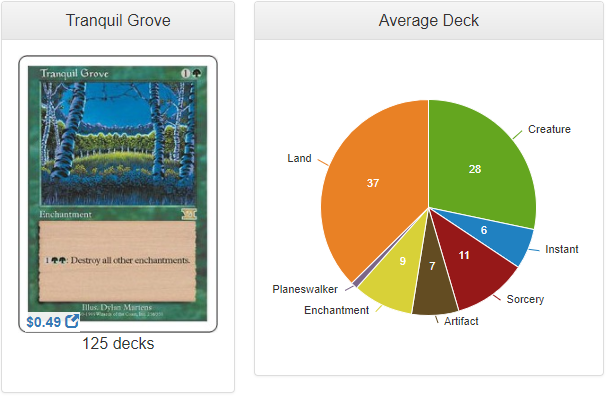
Keeping all of those pesky enchantments off the board, Tranquil GroveTranquil Grove sees play in 125 decks. Sure, it looks like it says "1GG: Destroy all other enchantments", but really this card says "Players can't cast enchantment spells." This card royally screws with most Uril, the MiststalkerUril, the Miststalker, Sigarda, Host of HeronsSigarda, Host of Herons and Krond the Dawn-CladKrond the Dawn-Clad decks. And messes with other decks incidentally. No more Blind ObedienceBlind Obediences. No more Leyline of the VoidLeyline of the Voids. No more Phyrexian ArenaPhyrexian Arenas, Mirari's WakeMirari's Wakes, or Rhystic StudyRhystic Studys. Enchantments are played heavily in EDH, in part because they're powerful, but also because they're often difficult to remove. With one simple card, you can keep the board clear of them.
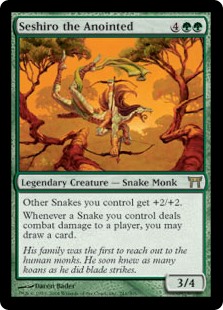
Seshiro the AnointedSeshiro the Anointed plays this card the most at seven decks. This is a goodstuff card that fits any deck running green. The only deck you're not going to want to put it in is an enchantress deck and/or an aura voltron commander. Other than that, play this in anything. Vorinclex, Voice of HungerVorinclex, Voice of Hunger, The Gitrog MonsterThe Gitrog Monster, Samut, Voice of DissentSamut, Voice of Dissent, Kynaios and Tiro of MeletisKynaios and Tiro of Meletis, whatever. So long as you aren't running very many enchantments yourself, this card is gold.

Call of the WildCall of the Wild is a cheats-creatures-into-play enchantment that sees play in 246 decks. When I covered Shadowmoor and Eventide I talked about Impromptu RaidImpromptu Raid. Call of the Wild is that card's big brother. For a little bit more mana, you get to keep whatever creatures you flip. Green already has some decent top deck manipulation with cards like Mirri's GuileMirri's Guile and Sylvan LibrarySylvan Library to stack the top three, while Vizier of the MenagerieVizier of the Menagerie and Garruk's HordeGarruk's Horde ensure that you never activate it and whiff. If you have a deck stacked with giant beefcakes that cost a ton of mana, this card is awesome.
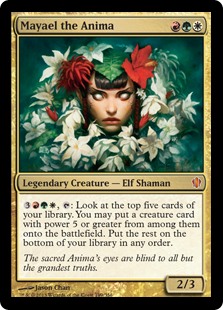
Mayael the AnimaMayael the Anima, who runs 34 creatures on average (that seems kind of low), plays this card the most at 47 decks. Any green deck playing nearly mono-creatures should be able to get some use out of Call of the Wild. Ruric Thar, the UnbowedRuric Thar, the Unbowed, Xenagos, God of RevelsXenagos, God of Revels, and Momir Vig, Simic VisionaryMomir Vig, Simic Visionary all have good synergy with this card. Momir Vig is particularly nice because you can stack your deck specifically with his ability.
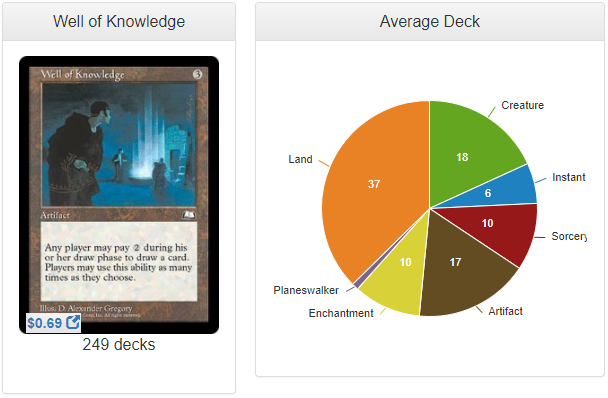
Well of KnowledgeWell of Knowledge is a group hug-type draw engine that sees play in 249 decks. This card is more of a meta call. If your table is full of greedy players and more political plays, this card is going to be great. Really greedy players have a very high chance of paying too much mana to draw too many cards, find they don't have the ability to cast the things they want to cast, and then possibly have to discard down to hand size at the end of their disappointing turn. If this sounds like some of the people you play with, go grab a copy of this card and try it out. If not, if you're playing in a meta like Dana Roach's where other players will kill you for running innocent, fun group hug cards, then just pretend we didn't talk about this card today.

Sasaya, Orochi AscendantSasaya, Orochi Ascendant plays this card the most at 27 decks, trying really hard to hit those seven lands. I like this card for any commander that can abuse it better than the rest of the table. Kruphix, God of HorizonsKruphix, God of Horizons is ideal for this. Kruphix can hoard your mana and then blow it all to draw a bunch of cards which you won't have to discard because Kruphix takes away your maximum hand size. Nice. Kydele, Chosen of KruphixKydele, Chosen of Kruphix also has some good, albeit slightly clunkier, synergy with Well of Knowledge. This would also be really sweet for Omnath, Locus of ManaOmnath, Locus of Mana, though you might just be better off running Rishkar's ExpertiseRishkar's Expertise there.
The Action
In this week's Action segment, I'm breaking out a nasty little Mazirek, Kraul Death PriestMazirek, Kraul Death Priest deck I've been tuning for awhile. I'm not convinced that the deck is "done," but it's not far off. This deck capitalizes on the "sacrifices a permanent" part of Mazirek's wording. I basically took Death CloudDeath Cloud and asked myself "how can I make this a deck?" This is the deck you break out when you want to make some enemies that carry over from game to game. Be careful.
[Commander]
*1 Mazirek, Kraul Death Priest
[/Commander]
[Artifacts]
*1 Sol Ring
*1 Swiftfoot Boots
*1 Golgari Signet
*1 Lifecrafter's Bestiary
*1 Birthing Pod
[/Artifacts]
[Creatures]
*1 Deathrite Shaman
*1 Birds of Paradise
*1 Elvish Mystic
*1 Llanowar Elves
*1 Spore Frog
*1 Caustic Caterpillar
*1 Elves of Deep Shadow
*1 Viscera Seer
*1 Moriok Replica
*1 Gyre Sage
*1 Sakura-Tribe Elder
*1 Blightsoil Druid
*1 Nezumi Graverobber
*1 Apprentice Necromancer
*1 Winding Constrictor
*1 Doomed Necromancer
*1 Yahenni, Undying Partisan
*1 Grim Haruspex
*1 Mogis's Marauder
*1 Merciless Executioner
*1 Fleshbag Marauder
*1 Ramunap Excavator
*1 Eternal Witness
*1 Reyhan, Last of the Abzan
*1 Crystalline Crawler
*1 Brawn
*1 Smothering Abomination
*1 Creakwood Liege
*1 Jarad, Golgari Lich Lord
*1 Corpse Connoisseur
*1 Puppeteer Clique
*1 Sidisi, Undead Vizier
*1 The Gitrog Monster
*1 Regal Behemoth
*1 Butcher of Malakir
*1 Genesis Hydra
*1 Lifeblood Hydra
[/Creatures]
[Enchantments]
*1 Retribution of the Ancients
*1 Hardened Scales
*1 Pernicious Deed
*1 Infernal Tribute
*1 Grave Pact
*1 Dictate of Erebos
*1 Dawn of the Dead
[/Enchantments]
[Instants]
*1 Crop Rotation
*1 Constant Mists
*1 Urborg Justice
*1 Harrow
*1 Wake the Dead
[/Instants]
[Lands]
*5 Swamp
*4 Forest
*1 Tranquil Thicket
*1 Blooming Marsh
*1 Svogthos, the Restless Tomb
*1 Crypt of Agadeem
*1 Temple of Malady
*1 Barren Moor
*1 Command Tower
*1 Nykthos, Shrine to Nyx
*1 Rogue's Passage
*1 Bojuka Bog
*1 Blighted Woodland
*1 Golgari Rot Farm
*1 Drownyard Temple
*1 Overgrown Tomb
*1 Grim Backwoods
*1 Desert of the Glorified
*1 Desert of the Indomitable
*1 Ifnir Deadlands
*1 Verdant Catacombs
*1 Hashep Oasis
*1 Blighted Fen
*1 Urborg, Tomb of Yawgmoth
*1 Cabal Coffers
*1 Strip Mine
*1 Wasteland
*1 Dust Bowl
*1 Glacial Chasm
[/Lands]
[Planeswalkers]
*1 Garruk Relentless
[/Planeswalkers]
[Sorceries]
*1 Smallpox
*1 Victimize
*1 Splendid Reclamation
*1 Dread Return
*1 Barter in Blood
*1 Death Cloud
*1 Living Death
*1 Rishkar's Expertise
[/Sorceries]
[/Deck]
Dean Gootee
Dean is a father, writer, and long-time fan of Magic and gaming in general. Currently located in Rochester, NY; he loves playing with new people, so if you're ever in the area, shoot him a message. Follow him on Twitter @GrubFellow, where he tweets #dailyEDH microcontent.
Your opinions are welcome. We love hearing what you think about Magic! We ask that you are always respectful when commenting. Please keep in mind how your comments could be interpreted by others. Personal attacks on our writers or other commenters will not be tolerated. Your comments may be removed if your language could be interpreted as aggressive or disrespectful. You may also be banned from writing further comments.
